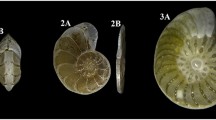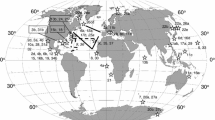Abstract
The protobranch bivalve Solemya velum Say, 1822 has large gills, which harbor chemolithoautotrophic bacteria that supply the majority of the clam’s organic carbon. A substantial portion of the CO2, O2, H2S, and other nutrients necessary for symbiont autotrophy and host heterotrophy are acquired from the environment through the gills, whose large size may be necessary to facilitate the acquisition of sufficient O2 from S. velum’s habitat to meet the combined demands of the host and symbionts. Large gills may also result in an oversupply of CO2, which may in turn be responsible for the isotopically depleted δ13C values observed in S. velum biomass (−31 to −34‰). Alternatively, gill hypertrophy may simply be an adaptation to house a large population of symbionts adjacent to their environmental source of dissolved gases and other nutrients. To better understand gill function in this symbiosis, gill weights, gill surface areas, and foot δ13C values were measured as a function of total weights. S. velum gill weights were found to be a substantial portion of total clam weight, averaging 38% of wet weight, compared to nonsymbiotic protobranch bivalves Yoldia limatula Say, 1831 (5%) and Nucula proxima Say, 1822 (11%). Gill weights are a smaller percentage of total weight in larger individuals; the allometric equation for gill weight (G) as a function of total weight (M) is G=0.26M0.85. Dry weights scale similarly. Gill surface areas are immense; the average gill surface area measured was 107 cm2 g−1 total soft tissue wet weight, the highest value for any marine invertebrate. Gill surface area (SA) also scales with size (SA=69.8M0.85). When gill surface areas were calculated with respect to gill wet weights, they did not scale with size. The δ13C values do not scale with size either, consistent with high rates of CO2 supply at all sizes. Extraordinarily high rates of CO2 supply relative to demand are supported by a model for CO2 delivery based on Fick’s law and the allometric relationship between surface areas and total weight, consistent with a role for large gill surface areas in the generation of isotopically depleted tissue δ13C values.






Similar content being viewed by others
References
Andersen AC, Jolivet S, Claudinot S, Lallier FH (2002) Biometry of the branchial plume in the hydrothermal vent tubeworm Riftia pachyptila. Can J Zool 80:320–332
Anderson AE, Childress JJ, Favuzzi JA (1987) Net uptake of CO2 driven by sulphide and thiosulphate oxidation in the bacterial symbiont-containing clam Solemya reidi. J Exp Biol 133:1–31
Cavanaugh CM (1983) Symbiotic chemoautotrophic bacteria in marine invertebrates from sulphide-rich habitats. Nature 302:58–61
Cavanaugh CM (1985) Symbioses of chemoautotrophic bacteria and marine invertebrates from hydrothermal vents and reducing sediments. Biol Soc Wash Bull 6:373–388
Cavanaugh CM (1994) Microbial symbiosis: patterns of diversity in the marine environment. Am Zool 34:79–89
Cavanaugh CM, Robinson JJ (1996) CO2 fixation in chemoautotroph-invertebrate symbioses: Expression of form I and form II RuBisCO. In: Lidstrom ME, Tabita FR (eds) Microbial growth on C1 compounds. Kluwer, Dordrecht, The Netherlands, pp 285–292
Cavanaugh CM, Abbott MS, Veenhuis M (1988) Immunochemical localization of ribulose 1,5 bisphosphate carboxylase in the symbiont containing gills of Solemya velum (Bivalvia: Mollusca). Proc Natl Acad Sci U S A 85:7786–7789
Childress JJ, Fisher CR (1992) The biology of hydrothermal vent animals: physiology, biochemistry, and autotrophic symbioses. Oceanogr Mar Biol Annu Rev 30:337–441
Conway N, Capuzzo J, Fry B (1989) The role of endosymbiotic bacteria in the nutrition of Solemya velum: evidence from a stable isotope analysis of endosymbionts and hosts. Limnol Oceanogr 34:249–255
Dando PR, Southward AJ, Southward EC (1986) Chemoautotrophic symbionts in the gills of the bivalve mollusc Lucinoma borealis and the sedimentary chemistry of its habitat. Proc R Soc Lond B 227:227–247
Eisen JA, Smith SW, Cavanaugh CM (1992) Phylogenetic relationship of chemoautotrophic bacterial symbionts of Solemya velum Say (Mollusca: Bivalvia) determined by 16S rRNA gene sequence analysis. J Bacteriol 174:3416–3421
Fisher CR (1990) Chemoautotrophic and methanotrophic symbioses in marine invertebrates. Rev Aquat Sci 2:399–436
Fisher CR, Childress JJ (1986) Translocation of fixed carbon from symbiotic bacteria to host tissues in the gutless bivalve, Solemya reidi. Mar Biol 93:59–68
Fisher C, Childress J, Arp A, Brooks J, Distel D, Favrizzi J, Felbeck H, Hessler R, Johnson K, Kennicutt M II, Macko S, Newton A, Powell M, Somero G, Soto T (1988a) Microhabitat variation in the hydrothermal vent mussel, Bathymodiolus thermophilus, at the Rose Garden vent on the Galapagos rift. Deep-Sea Res 35:1769–1791
Fisher CR, Childress JJ, Arp AJ, Brooks JM, Distel D, Favuzzi JA, Felbeck H, Fritz LW, Hessler R, Johnson KS, Kennicutt MC II, Lutz RA, Macko SA, Newton A, Powell MA, Somero GN, Soto T (1988b) Variation in the hydrothermal vent clam, Calyptogena magnifica, at Rose Garden vent on the Galapagos rift. Deep-Sea Res 35:1811–1832
Fisher CR, Kennicutt MC, Brooks JM (1990) Stable carbon isotope evidence for carbon limitation in hydrothermal vent vestimentiferans. Science 247:1094–1096
Goericke R, Montoya JP, Fry B (1994) Physiology of isotopic fractionation in algae and cyanobacteria. In: Lajtha K, Michener RH (eds) Stable isotopes in ecology and environmental science. Blackwell Scientific, Boston, pp 187–221
Hourdez S, Frederick L, Schernecke A, Fisher CR (2001) Functional respiratory anatomy of a deep-sea orbiniid polychaete from the Brine Pool NR-1 in the Gulf of Mexico. Invert Biol 120:29–40
Jouin C, Gaill F (1990) Gills of hydrothermal vent annelids: structure, ultrastructure and functional implications in two alvinellid species. Progr Oceanogr 24:59–69
Krueger DM, Gallagher SM, Cavanaugh CM (1992) Suspension feeding on phytoplankton by Solemya velum, a symbiont-containing clam. Mar Ecol Prog Ser 86:145–151
Nelson D, Fisher C (1995) Chemoautotrophic and methanotrophic endosymbiotic bacteria at deep-sea vents and seeps. In: Karl D (ed) Microbiology of deep-sea hydrothermal vents. CRC Press, Boca Raton, FL, pp 125–167
Pouvreau S, Jonquieres G, Buestel D (1999) Filtration by the pearl oyster, Pinctada margaritifera under conditions of low seston load and small particle size in a tropical lagoon habitat. Aquaculture 176:295–314
Robinson JJ, Cavanaugh CM (1995) Expressions of form I and form II Rubisco in chemoautotrophic symbioses: implications for the interpretation of stable carbon isotope values. Limnol Oceanogr 40:1496–1502
Scott KM, Fisher CR, Vodenichar JS, Nix ER, Minnich E (1994) Inorganic carbon and temperature requirements for autotrophic carbon fixation by the chemoautotrophic symbionts of the giant hydrothermal vent tube worm, Riftia pachyptila. Physiol Zool 67:617–638
Scott KM, Schwedock J, Schrag DP, Cavanaugh CM (2004) Influence of form IA RubisCO and environmental dissolved inorganic carbon on the δ13C of the clam-bacterial chemoautotrophic symbiosis Solemya velum. Environ Microbiol 6:1210–1219
Stanley S (1970) Shell form and life habitats of the Bivalvia. Geol Soc Am Mem 125:119–121
Zardus JD (2002) Protobranch bivalves. Adv Mar Biol 42:1–65
Zeebe RE, Wolf-Gladrow D (2003) CO2 in seawater: equilibrium, kinetics, isotopes. Elsevier, New York
Acknowledgments
I am extremely grateful to the Marine Resources Center of the Marine Biological Laboratory for bivalve collections, and to Colleen Cavanaugh for discussions of gas exchange in this and other bivalve symbioses. Special thanks are due to Shana Goffredi and Florence Thomas for their many helpful suggestions on drafts of this manuscript. All experiments were conducted in compliance with the current laws of the United States of America.
Author information
Authors and Affiliations
Corresponding author
Additional information
Communicated by J. P. Grassle, New Brunswick
Rights and permissions
About this article
Cite this article
Scott, K.M. Allometry of gill weights, gill surface areas, and foot biomass δ13C values of the chemoautotroph–bivalve symbiosis Solemya velum. Marine Biology 147, 935–941 (2005). https://doi.org/10.1007/s00227-005-1630-9
Received:
Accepted:
Published:
Issue Date:
DOI: https://doi.org/10.1007/s00227-005-1630-9




